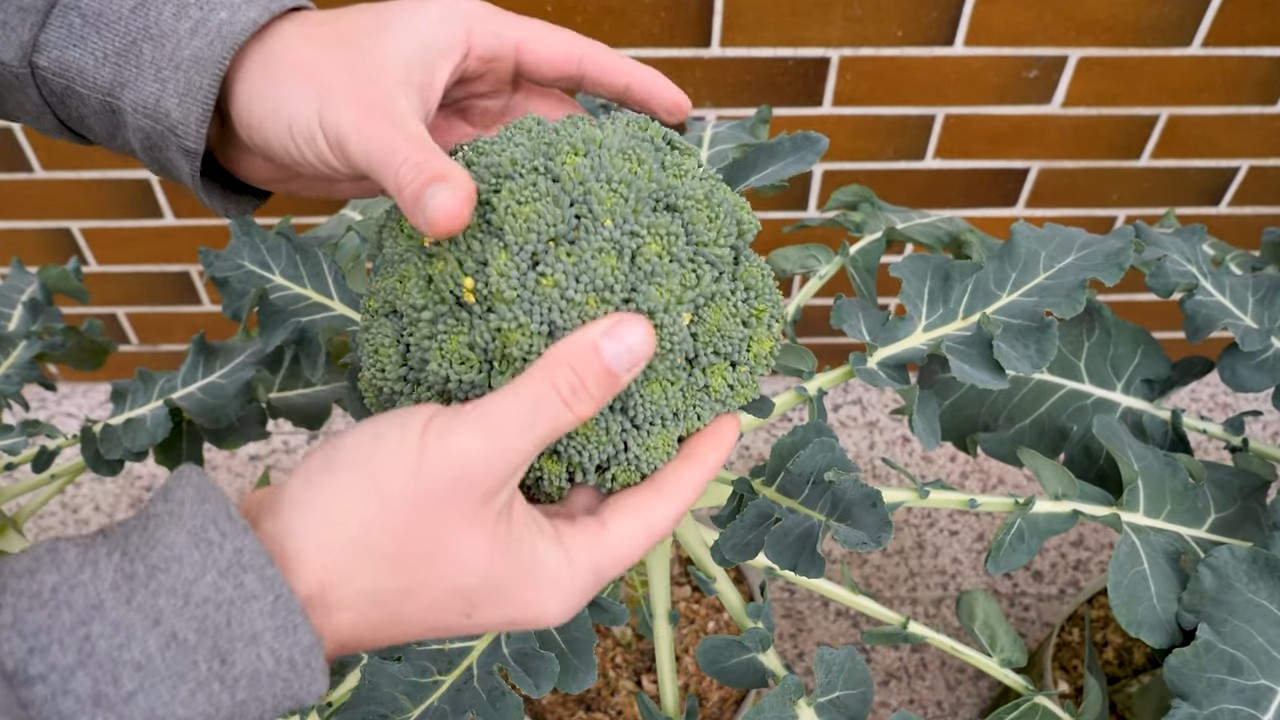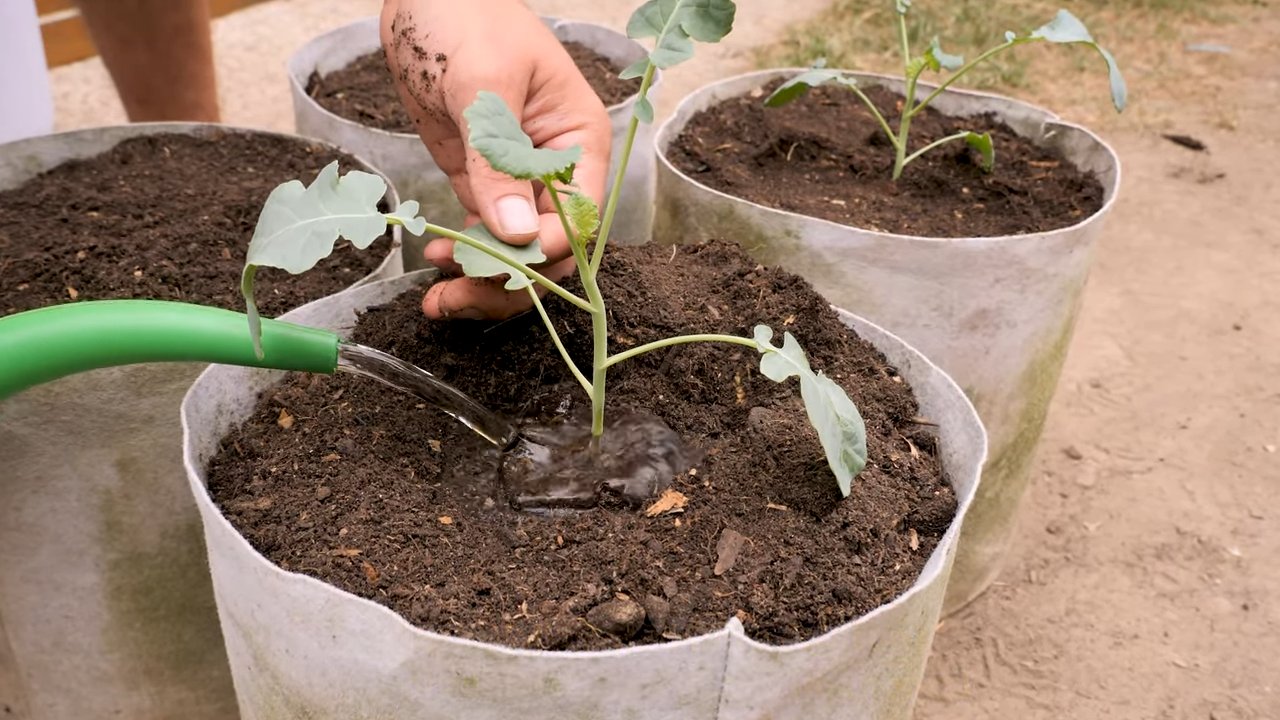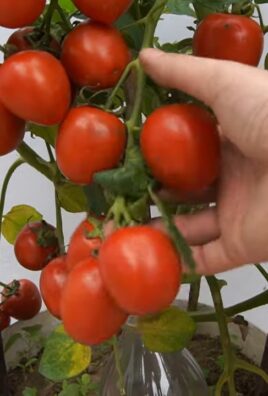Grow Broccoli at Home: Imagine stepping into your backyard and harvesting crisp, vibrant broccoli florets, ready to be steamed, roasted, or tossed into a delicious salad. Sounds dreamy, right? Well, it doesn’t have to be just a dream! This DIY guide is your key to unlocking the secrets of cultivating this nutritional powerhouse right in your own garden.
Broccoli, a member of the Brassica family, has a rich history dating back to the Roman Empire, where it was highly valued for its health benefits and unique flavor. From ancient Roman feasts to modern-day dinner tables, broccoli has consistently proven its worth as a versatile and nutritious vegetable. But why rely solely on grocery stores when you can experience the joy of growing your own?
In today’s world, knowing where your food comes from is more important than ever. Growing your own broccoli allows you to control the entire process, ensuring that your veggies are free from harmful pesticides and packed with flavor. Plus, let’s be honest, there’s something incredibly satisfying about nurturing a plant from seed to harvest. This DIY article will provide you with simple, effective tricks and hacks to grow broccoli at home, even if you have limited space or gardening experience. I’m excited to share these tips with you, so you can enjoy fresh, homegrown broccoli all season long!

Brokkoli selbst anbauen: Dein umfassender DIY-Leitfaden
Hey Gartenfreunde! Habt ihr euch jemals gefragt, wie ihr diesen gesunden, grünen Superhelden direkt in eurem Garten anbauen könnt? Brokkoli ist nicht nur lecker und nahrhaft, sondern auch überraschend einfach anzubauen, wenn man ein paar grundlegende Dinge beachtet. In diesem Artikel zeige ich euch Schritt für Schritt, wie ihr euren eigenen Brokkoli erfolgreich anbauen könnt – egal ob im Gartenbeet oder im Topf auf dem Balkon. Los geht’s!
Was du für den Brokkoli-Anbau brauchst
Bevor wir loslegen, hier eine Liste der Dinge, die du für den Brokkoli-Anbau benötigst:
* Brokkolisamen oder Jungpflanzen: Du kannst entweder mit Samen beginnen oder Jungpflanzen kaufen, um den Prozess zu beschleunigen.
* Anzuchterde (optional): Wenn du mit Samen beginnst, brauchst du Anzuchterde für die Voranzucht.
* Gartenerde oder Pflanzerde: Für das Beet oder den Topf, in dem der Brokkoli wachsen soll.
* Kompost oder organischer Dünger: Um den Boden mit Nährstoffen anzureichern.
* Gießkanne oder Gartenschlauch: Zum regelmäßigen Gießen.
* Gartenwerkzeug: Spaten, Schaufel, Harke (je nach Bedarf).
* Pflanzgefäße (optional): Wenn du Brokkoli im Topf anbauen möchtest.
* Schneckenkorn oder Schutznetz (optional): Zum Schutz vor Schädlingen.
Der richtige Zeitpunkt für die Aussaat und Pflanzung
Der Zeitpunkt für die Aussaat und Pflanzung hängt von deinem Klima und der Brokkolisorte ab. Generell gibt es zwei Hauptanbauzeiten:
* Frühjahrsanbau: Aussaat im Haus ab Februar/März, Pflanzung ins Freie ab April/Mai (nach den letzten Frösten).
* Herbstanbau: Aussaat im Haus ab Juni/Juli, Pflanzung ins Freie ab August/September.
Ich empfehle, die Anweisungen auf der Samenpackung oder dem Etikett der Jungpflanzen zu beachten, da diese spezifische Empfehlungen für die jeweilige Sorte enthalten.
Brokkoli vorziehen (optional)
Wenn du mit Samen beginnst, ist das Vorziehen im Haus eine gute Möglichkeit, den Pflanzen einen Vorsprung zu verschaffen. So geht’s:
1. Aussaat: Fülle kleine Anzuchttöpfe oder eine Anzuchtschale mit Anzuchterde. Säe die Brokkolisamen etwa 1 cm tief in die Erde.
2. Gießen: Befeuchte die Erde vorsichtig mit einer Sprühflasche oder Gießkanne. Die Erde sollte feucht, aber nicht nass sein.
3. Standort: Stelle die Anzuchttöpfe an einen hellen, warmen Ort. Eine Temperatur von 18-20°C ist ideal.
4. Keimung: Die Samen keimen in der Regel innerhalb von 5-10 Tagen.
5. Pflege: Halte die Erde feucht und dünne die Sämlinge aus, sobald sie groß genug sind, um sie zu handhaben. Entferne schwache oder überzählige Pflanzen, sodass die verbleibenden Pflanzen genügend Platz zum Wachsen haben.
6. Abhärten: Bevor du die Jungpflanzen ins Freie pflanzt, solltest du sie abhärten. Stelle sie dazu für einige Tage stundenweise ins Freie, um sie an die Bedingungen im Garten zu gewöhnen.
Brokkoli im Gartenbeet pflanzen
Wenn du Brokkoli im Gartenbeet anbauen möchtest, solltest du folgende Schritte beachten:
1. Standortwahl: Wähle einen sonnigen Standort mit mindestens 6 Stunden direkter Sonneneinstrahlung pro Tag. Brokkoli bevorzugt einen gut durchlässigen, fruchtbaren Boden.
2. Bodenvorbereitung: Lockere den Boden gründlich auf und entferne Unkraut und Steine. Arbeite Kompost oder organischen Dünger in den Boden ein, um ihn mit Nährstoffen anzureichern.
3. Pflanzabstand: Pflanze die Brokkolipflanzen in einem Abstand von 45-60 cm zueinander. Bei Reihenpflanzung sollte der Abstand zwischen den Reihen etwa 75 cm betragen.
4. Pflanzen: Grabe ein Loch, das groß genug ist, um den Wurzelballen der Pflanze aufzunehmen. Setze die Pflanze ein und fülle das Loch mit Erde. Drücke die Erde leicht an.
5. Gießen: Gieße die Pflanzen nach dem Einpflanzen gründlich.
6. Mulchen: Bringe eine Schicht Mulch um die Pflanzen herum auf, um die Feuchtigkeit im Boden zu halten und Unkrautwachstum zu unterdrücken.
Brokkoli im Topf anbauen
Auch im Topf lässt sich Brokkoli prima anbauen. Hier sind die wichtigsten Punkte:
1. Topfgröße: Wähle einen Topf mit einem Durchmesser von mindestens 30 cm und einem Volumen von mindestens 20 Litern.
2. Pflanzerde: Verwende hochwertige Pflanzerde, die gut durchlässig ist.
3. Drainage: Achte darauf, dass der Topf über ausreichend Drainagelöcher verfügt, damit überschüssiges Wasser ablaufen kann.
4. Pflanzen: Pflanze eine Brokkolipflanze pro Topf.
5. Standort: Stelle den Topf an einen sonnigen Standort mit mindestens 6 Stunden direkter Sonneneinstrahlung pro Tag.
6. Gießen: Gieße die Pflanze regelmäßig, besonders an heißen Tagen. Die Erde sollte immer leicht feucht sein, aber nicht nass.
7. Düngen: Dünge die Pflanze regelmäßig mit einem Flüssigdünger für Gemüse.
Pflege des Brokkolis
Die richtige Pflege ist entscheidend für eine erfolgreiche Brokkoli-Ernte. Hier sind einige wichtige Tipps:
* Gießen: Brokkoli benötigt regelmäßig Wasser, besonders während der Wachstumsphase. Achte darauf, dass die Erde immer leicht feucht ist. Vermeide Staunässe, da dies zu Wurzelfäule führen kann.
* Düngen: Brokkoli ist ein Starkzehrer und benötigt viele Nährstoffe. Dünge die Pflanzen regelmäßig mit einem organischen Dünger oder einem Flüssigdünger für Gemüse.
* Unkrautbekämpfung: Entferne regelmäßig Unkraut, das um die Brokkolipflanzen herum wächst. Unkraut konkurriert mit dem Brokkoli um Nährstoffe und Wasser.
* Schädlingsbekämpfung: Brokkoli kann von verschiedenen Schädlingen befallen werden, wie z.B. Kohlweißlingen, Blattläusen und Schnecken. Kontrolliere die Pflanzen regelmäßig auf Schädlinge und ergreife bei Bedarf Maßnahmen zur Bekämpfung. Du kannst z.B. Schneckenkorn verwenden oder die Pflanzen mit einem Schutznetz abdecken.
* Krankheitsvorbeugung: Achte auf eine gute Belüftung der Pflanzen, um Pilzkrankheiten vorzubeugen. Vermeide es, die Blätter beim Gießen zu benetzen.
Erntezeit und -methode
Die Erntezeit hängt von der Brokkolisorte und den Anbaubedingungen ab. In der Regel ist Brokkoli etwa 60-80 Tage nach der Pflanzung erntereif.
* Erntezeitpunkt: Ernte den Brokkoli, wenn die Röschen fest und geschlossen sind. Wenn die Röschen gelb werden oder sich öffnen, ist der Brokkoli überreif.
* Erntemethode: Schneide den Brokkolikopf mit einem scharfen Messer ab. Lasse dabei etwa 15 cm des Stiels stehen. Oft bilden sich an den Seitentrieben noch kleinere Röschen, die du später ernten kannst.
Häufige Probleme und Lösungen
Auch beim Brokkoli-Anbau können Probleme auftreten. Hier sind einige häufige Probleme und mögliche Lösungen:
* Gelbe Blätter: Gelbe Blätter können ein Zeichen für Nährstoffmangel sein. Dünge die Pflanzen mit einem geeigneten Dünger.
* Kleine Köpfe: Kleine Köpfe können durch Wassermangel oder Nährstoffmangel verursacht werden. Achte auf eine ausreichende Bewässerung und Düngung.
*

Conclusion
So, there you have it! Growing your own broccoli at home isn’t just a gardening project; it’s an investment in your health, your taste buds, and your connection to the natural world. We’ve walked you through the essential steps, from selecting the right variety to warding off common pests, and hopefully, demystified the process along the way.
Why is this DIY trick a must-try? Because store-bought broccoli, while convenient, often lacks the vibrant flavor and nutritional punch of freshly harvested, homegrown broccoli. Think about it: you control the entire process, from the quality of the soil to the timing of the harvest. This means you can ensure your broccoli is packed with vitamins, minerals, and that unmistakable, slightly sweet, slightly earthy taste that only comes from truly fresh produce. Plus, there’s an undeniable satisfaction in nurturing a plant from seed to table.
But the benefits extend beyond just taste and nutrition. Growing your own broccoli is also a sustainable choice. You’re reducing your carbon footprint by eliminating the transportation and packaging associated with commercially grown produce. You’re also contributing to a healthier ecosystem by avoiding harmful pesticides and herbicides (or at least minimizing their use).
Ready to take your broccoli game to the next level? Consider these variations and suggestions:
* Succession Planting: Plant new broccoli seedlings every few weeks to ensure a continuous harvest throughout the growing season. This is especially useful in regions with mild climates.
* Companion Planting: Plant broccoli alongside herbs like rosemary, thyme, and sage to deter pests and improve the overall health of your garden. Marigolds are also excellent companions for their pest-repelling properties.
* Broccoli Raab: If you’re short on space or want a quicker harvest, try growing broccoli raab. It’s a close relative of broccoli that produces smaller florets and edible leaves, ready to harvest in just a few weeks.
* Experiment with Varieties: Don’t be afraid to try different broccoli varieties to find your favorites. Some popular choices include ‘Waltham 29’, ‘DiCicco’, and ‘Calabrese’. Each variety has its own unique flavor and growth characteristics.
* Fermented Broccoli Stalks: Don’t throw away those broccoli stalks! They’re packed with nutrients and can be fermented to create a delicious and probiotic-rich condiment.
Growing broccoli at home is a rewarding experience that offers numerous benefits, from improved health and flavor to environmental sustainability. It’s a chance to connect with nature, learn new skills, and enjoy the fruits (or rather, vegetables) of your labor.
We wholeheartedly encourage you to give this DIY trick a try. Start small, be patient, and don’t be afraid to experiment. And most importantly, share your experience with us! We’d love to hear about your successes, your challenges, and any tips or tricks you’ve discovered along the way. Post your photos and stories on social media using [Your Hashtag Here] and let’s build a community of home broccoli growers! Happy gardening!
Frequently Asked Questions (FAQ)
How much space do I need to grow broccoli?
Broccoli plants typically need about 18-24 inches of space between them to allow for proper growth and air circulation. If you’re planting in rows, space the rows about 3 feet apart. However, you can also grow broccoli in containers, provided they are large enough (at least 5 gallons) to accommodate the plant’s root system. Container gardening is a great option if you have limited space or want to protect your plants from pests. Remember to choose a sunny location for your broccoli, whether it’s in the ground or in a container.
What kind of soil is best for growing broccoli?
Broccoli thrives in well-drained, fertile soil that is rich in organic matter. The ideal soil pH is between 6.0 and 7.0. Before planting, amend your soil with compost, aged manure, or other organic materials to improve its fertility and drainage. If your soil is heavy clay, consider adding sand or perlite to improve drainage. A soil test can help you determine the pH and nutrient levels of your soil and identify any amendments that may be needed.
How often should I water my broccoli plants?
Broccoli plants need consistent moisture to thrive. Water deeply and regularly, especially during dry periods. Aim to keep the soil consistently moist but not waterlogged. A good rule of thumb is to water when the top inch of soil feels dry to the touch. Mulching around your broccoli plants can help retain moisture and suppress weeds. Avoid overhead watering, as this can increase the risk of fungal diseases. Instead, water at the base of the plants.
What are some common pests and diseases that affect broccoli?
Broccoli is susceptible to a variety of pests and diseases, including cabbage worms, aphids, flea beetles, and clubroot. To prevent pest problems, consider using row covers to protect your plants from insects. You can also handpick pests off your plants or use insecticidal soap or neem oil to control infestations. To prevent diseases, ensure good air circulation around your plants and avoid overhead watering. If you notice signs of disease, remove affected leaves and treat your plants with a fungicide if necessary. Crop rotation can also help prevent soilborne diseases.
When is the best time to harvest broccoli?
Broccoli is typically ready to harvest when the central head is firm and tight, and the florets are still green and unopened. The exact timing will depend on the variety and growing conditions, but generally, broccoli is ready to harvest about 50-70 days after transplanting. Use a sharp knife to cut the head from the plant, leaving a few inches of stem. After harvesting the central head, side shoots may develop, providing you with additional harvests.
Can I grow broccoli in the winter?
In regions with mild winters, you can grow broccoli as a fall or winter crop. Choose a variety that is known to be cold-hardy and plant it in late summer or early fall. Provide protection from frost and freezing temperatures by covering your plants with row covers or blankets. In colder climates, you can start broccoli indoors in late winter and transplant it outdoors in early spring.
What are some good companion plants for broccoli?
Companion planting can help improve the health and productivity of your broccoli plants. Some good companion plants for broccoli include:
* Herbs: Rosemary, thyme, sage, dill, and mint can help deter pests.
* Flowers: Marigolds and nasturtiums can attract beneficial insects and repel pests.
* Vegetables: Onions, garlic, and carrots can help deter pests.
* Legumes: Clover and beans can help fix nitrogen in the soil.
Avoid planting broccoli near other members of the brassica family, such as cabbage, cauliflower, and kale, as they can attract the same pests and diseases.
How can I prevent my broccoli from bolting (going to seed)?
Bolting is when a plant prematurely flowers and goes to seed, which can make the broccoli head bitter and inedible. Bolting is often caused by stress, such as heat, drought, or nutrient deficiencies. To prevent bolting, ensure your broccoli plants receive consistent moisture and nutrients. Provide shade during hot weather and harvest the heads as soon as they are ready.
Is it possible to grow organic broccoli at home?
Absolutely! Growing organic broccoli at home is a great way to ensure you’re eating healthy, pesticide-free produce. Use organic soil amendments, such as compost and aged manure, to fertilize your plants. Control pests with natural methods, such as handpicking, insecticidal soap, and neem oil. Avoid using synthetic fertilizers, pesticides, and herbicides.
What can I do with the broccoli leaves?
Don’t throw away those broccoli leaves! They are edible and nutritious. You can sauté them, steam them, or add them to soups and stews. They have a slightly bitter taste, similar to kale or collard greens. You can also use them to make pesto or add them to smoothies.





Leave a Comment